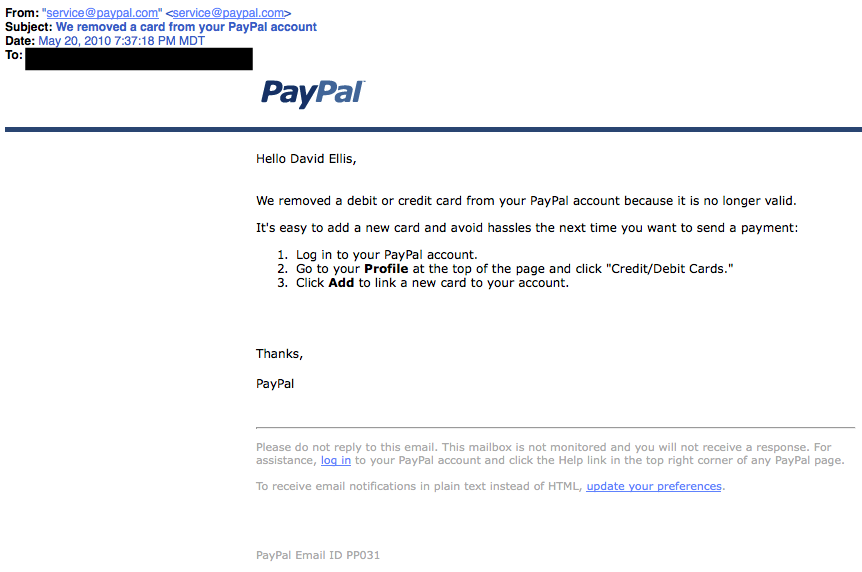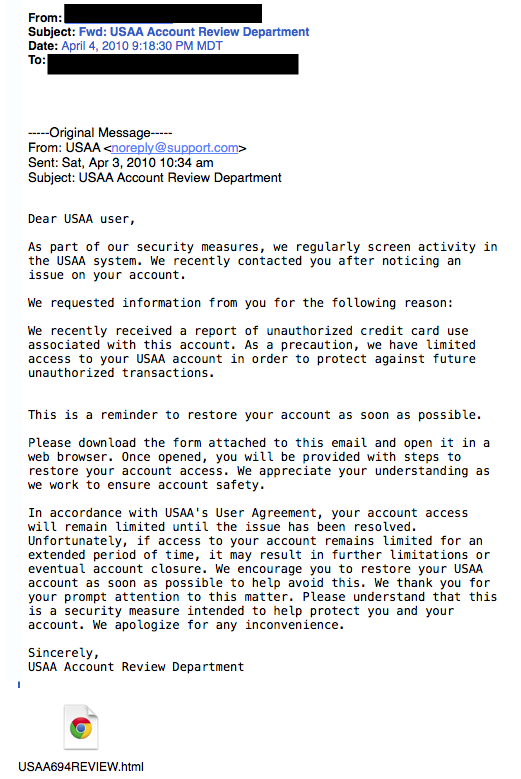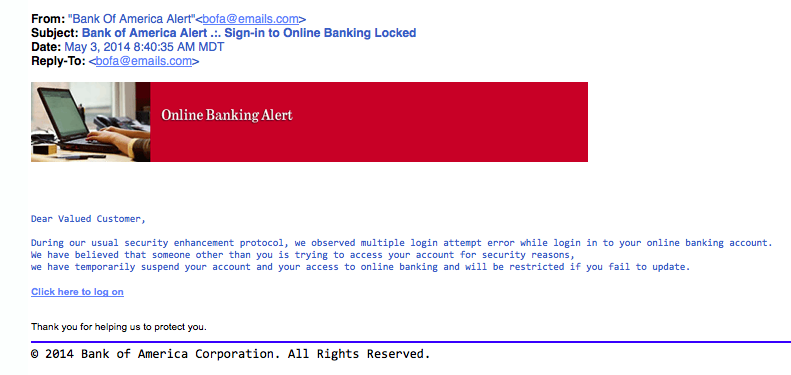Criminals have countless methods to trick email users.  By: David EllisPhishing is the electronic version of social engineering and has found a huge market in our email-obsessed world. Hackers send fraudulent emails out to tens of thousands of people, hoping a few will click on attached links, documents, or pictures. The goal? Get recipients to willingly provide valuable social security numbers, passwords, banking numbers, PINs, and credit card numbers.
By: David EllisPhishing is the electronic version of social engineering and has found a huge market in our email-obsessed world. Hackers send fraudulent emails out to tens of thousands of people, hoping a few will click on attached links, documents, or pictures. The goal? Get recipients to willingly provide valuable social security numbers, passwords, banking numbers, PINs, and credit card numbers. This is achieved through a few different methods. Sometimes, cybercriminals trick email recipients into opening an email attachment that loads harmful malware onto their system. Other times, they trick recipients into providing sensitive personal information directly via web forms. Either way, these seemingly teeny mistakes could make serious ripples across your organization, compromising either corporate or personal security.SEE ALSO: 7 Ways to Recognize a Phishing Email.Typically, phishers send legitimate-looking emails that appear as though they originated from reputable companies that many people do business with like BestBuy, Amazon, Federal Express, DHL, and PayPal. The emails often ask customers to confirm information or to go to the business site by clicking on a provided link, and often include a statement of impending consequences if you fail to act.Here are a few common ploys cybercriminals use to trick you.1. The Government ManeuverThis type of email looks like it originated from a federal body, such as the FBI, and tries to scare you into providing your information. Common messages include, ‘Your insurance has been denied because of incomplete information. Click here to provide your information.’ Or, ‘Because you illegally downloaded files, your Internet access will be revoked until you enter the requested information in the form below.’
This is achieved through a few different methods. Sometimes, cybercriminals trick email recipients into opening an email attachment that loads harmful malware onto their system. Other times, they trick recipients into providing sensitive personal information directly via web forms. Either way, these seemingly teeny mistakes could make serious ripples across your organization, compromising either corporate or personal security.SEE ALSO: 7 Ways to Recognize a Phishing Email.Typically, phishers send legitimate-looking emails that appear as though they originated from reputable companies that many people do business with like BestBuy, Amazon, Federal Express, DHL, and PayPal. The emails often ask customers to confirm information or to go to the business site by clicking on a provided link, and often include a statement of impending consequences if you fail to act.Here are a few common ploys cybercriminals use to trick you.1. The Government ManeuverThis type of email looks like it originated from a federal body, such as the FBI, and tries to scare you into providing your information. Common messages include, ‘Your insurance has been denied because of incomplete information. Click here to provide your information.’ Or, ‘Because you illegally downloaded files, your Internet access will be revoked until you enter the requested information in the form below.’ 2. The Friend TacticIf an unknown individual claims to know you in an email, you are probably not suffering from amnesia. More than likely, it is an attempt to get you to wire him/her money. A variation on this theme is that one of your known friends is in a foreign country and needs your help. Before you send your ‘friend’ money, give them a call to verify. Your true friend’s email contact list was probably hijacked.
2. The Friend TacticIf an unknown individual claims to know you in an email, you are probably not suffering from amnesia. More than likely, it is an attempt to get you to wire him/her money. A variation on this theme is that one of your known friends is in a foreign country and needs your help. Before you send your ‘friend’ money, give them a call to verify. Your true friend’s email contact list was probably hijacked. 3. The Billing ProblemThis phishing tactic is tricky because it appears quite legitimate. This email states that an item you purchased online cannot be shipped to you because the credit card was expired (or billing address wasn’t correct, etc.). If you click on the provided link, it takes you to a spoofed website and asks for updated payment/shipping information, etc.
3. The Billing ProblemThis phishing tactic is tricky because it appears quite legitimate. This email states that an item you purchased online cannot be shipped to you because the credit card was expired (or billing address wasn’t correct, etc.). If you click on the provided link, it takes you to a spoofed website and asks for updated payment/shipping information, etc. A lot of folks have personal and business PayPal accounts. Here, notice that the email header is from [email protected]. While that may sound legit, everything from PayPal will have an address of …@paypal.com4. The Expiration DateThis type of email falsely explains that your account with [company name] is about to expire, and you must sign in as soon as possible to avoid losing all your data. Conveniently enough, there is a link in the email, which again takes you to a spoofed login page.
A lot of folks have personal and business PayPal accounts. Here, notice that the email header is from [email protected]. While that may sound legit, everything from PayPal will have an address of …@paypal.com4. The Expiration DateThis type of email falsely explains that your account with [company name] is about to expire, and you must sign in as soon as possible to avoid losing all your data. Conveniently enough, there is a link in the email, which again takes you to a spoofed login page. 5. The Virus ScareThis type of email states that your computer has been infected! In order to avoid losing your data and infecting your computer the email instructs you to follow the provided link, or download the “anti-virus” attachment.
5. The Virus ScareThis type of email states that your computer has been infected! In order to avoid losing your data and infecting your computer the email instructs you to follow the provided link, or download the “anti-virus” attachment. Whatever you do, DON’T CLICK ON THE LINK!6. The Contest WinnerDon’t get too excited when you receive emails that claim you’ve won something, or received an inheritance from a relative you’ve never heard of. 99.9% of the time, these are absolutely bogus. To claim your prize, the email requires you click a link and enter your info for prize shipment.
Whatever you do, DON’T CLICK ON THE LINK!6. The Contest WinnerDon’t get too excited when you receive emails that claim you’ve won something, or received an inheritance from a relative you’ve never heard of. 99.9% of the time, these are absolutely bogus. To claim your prize, the email requires you click a link and enter your info for prize shipment. 7. The Friendly BankYour bank may offer account notifications when certain amounts are withdrawn from your accounts. This ploy tricks you with a fake account notification stating that an amount has been withdrawn from your account that exceeds your notification limit. If you have any questions about this withdrawal (which you probably would), it gives you a convenient link that leads to a web form asking for your bank account number “for verification purposes.” Instead of clicking on the link, give your bank a call. They may want to take action on the malicious email.
7. The Friendly BankYour bank may offer account notifications when certain amounts are withdrawn from your accounts. This ploy tricks you with a fake account notification stating that an amount has been withdrawn from your account that exceeds your notification limit. If you have any questions about this withdrawal (which you probably would), it gives you a convenient link that leads to a web form asking for your bank account number “for verification purposes.” Instead of clicking on the link, give your bank a call. They may want to take action on the malicious email. Due to the graphics and opt-out instructions, this phishing attempt seems very legitimate.8. The VictimBeing wrongly accused of something doesn’t feel good. This type of phishing email acts as an angry customer whom supposedly sent you money in return for a shipped product. The email concludes with the threat that they will inform the authorities if they don’t hear from you.
Due to the graphics and opt-out instructions, this phishing attempt seems very legitimate.8. The VictimBeing wrongly accused of something doesn’t feel good. This type of phishing email acts as an angry customer whom supposedly sent you money in return for a shipped product. The email concludes with the threat that they will inform the authorities if they don’t hear from you. This is another type of victim scam. Who wouldn’t be a little worried after receiving this email?9. The Tax CommunicationPractically everyone has annual taxes to submit. That’s why this phishing attempt is so popular. The message states that you are either eligible to receive a tax refund, or you have been selected to be audited. It then requests that you submit a tax refund request or tax form.
This is another type of victim scam. Who wouldn’t be a little worried after receiving this email?9. The Tax CommunicationPractically everyone has annual taxes to submit. That’s why this phishing attempt is so popular. The message states that you are either eligible to receive a tax refund, or you have been selected to be audited. It then requests that you submit a tax refund request or tax form. 10. The CheckupThis is one of the more unassuming phishing email attempts. It claims [company name] is conducting a routine security procedure and requests you verify your account by providing information. This scam is especially effective if you happen to be a customer of the named business.
10. The CheckupThis is one of the more unassuming phishing email attempts. It claims [company name] is conducting a routine security procedure and requests you verify your account by providing information. This scam is especially effective if you happen to be a customer of the named business. If you receive a phishing email:Don’t click on any links, open attachments, or expand any included picturesDon’t try to reply to the senderReport the scam (forward the e-mail to the FTC – [email protected])Delete the email from your computerIf you do legitimate business with a company mentioned in the phishing email, you can call the business and ask if they would like you to forward the email to them, so they may take further action.Was this post helpful? Share it!David Ellis (GCIH, QSA, PFI, CISSP) is Director of Forensic Investigations at SecurityMetrics with over 25 years of law enforcement and investigative experience. Check out his other blog posts.
If you receive a phishing email:Don’t click on any links, open attachments, or expand any included picturesDon’t try to reply to the senderReport the scam (forward the e-mail to the FTC – [email protected])Delete the email from your computerIf you do legitimate business with a company mentioned in the phishing email, you can call the business and ask if they would like you to forward the email to them, so they may take further action.Was this post helpful? Share it!David Ellis (GCIH, QSA, PFI, CISSP) is Director of Forensic Investigations at SecurityMetrics with over 25 years of law enforcement and investigative experience. Check out his other blog posts.
Measuring Your Success: Baseline and Continual Measurement
Here you are. You’ve done your cultural assessment, you were able to identify the holes in the organizations security awareness efforts, you modified training and created a 12 month content plan to fix this. It’s time to sit back, and see some real user behavior change right?
Quick question: How do you know that your plan worked? Are users reporting more issues to the help desk? Are people more able to identify phishing emails? Are users retaining the information from annual training through the year? Basically, if your boss walked in and asked for proof that the budget was put to good use will you have anything to provide besides ‘trust me?’
Probably not and because of that you need to measure the behavior within your organization. Without measuring user behavior you have no way of knowing how successful, or unsuccessful, your security awareness architecture is. You are also left in the situation of ‘fire fighter’ in that you only know that a hole (fire) is present when that hole creates a big problem (i.e., a password attack causing a major data breech).

The Value of Baseline Measurements
There are two types of measurement that are going to be pivotal in showing you significant changes in behavior: baseline and continual. Baseline measurement shows you how users were performing before any changes were made thereby providing you with a point of comparison. Lets say that you started your intervention in June and you measured user behavior through September (see ‘No Baseline graph’). Did your intervention work? To be perfectly honest, this graph shows nothing impressive at all. As a matter of fact, it looks like nothing has happened. Money well spent for sure.
Now lets add a baseline measurement and see how that looks.
Much better! Now you can clearly see that (1) help desk calls have significantly increased, and (2) the number of successful phishing attacks have significantly decreased!

Furthermore, your new training/content plan seems to be producing long term behavior change over the following months. Great job.
This example really outlines the value of baseline measurement. Without it you really have no way of knowing if you made it better, worse, or broke even.
The Value of Continual Measurement
Once you have shown the effectiveness of your security awareness efforts, is their value in consistent measurement after? Of course. Constant measurement of user behavior allows you to see behavior trends and address issues before they become a problem. Lets go back to the help desk and phishing attack example. You continued to measure user behavior for several more months and suddenly you saw this.

What happened? Not only are your users not calling the help desk but they are also falling prey to more phishing attacks. They are performing similar to before your new training and content plan was implemented. Upon further investigation you find out that a new phishing method was just released and your users are having a hard time identifying it. This also leads to less calls to the help desk.
While initially this may seem like a giant leap in the wrong direction, it is exactly what behavior measurement is for. Security threats evolve and your security awareness architecture has to evolve with it. By measuring user behavior consistently you are able to see when patterns like this occur and develop an intervention (e.g., a news letter, quick email) that addresses this before it creates a big problem for your users and you.
Security Awareness Content: Challenges of Using Punishment
Punishment is evident in all aspects of our life to everything from getting drivers to stop speeding, to getting the dog to not bark at the mailman. Because of this, it is no wonder that several go to punishment when wanting to change user behavior. While punishment is a very powerful tool- that can produce almost immediate change in behavior- it is very hard to control and very hard to maintain. For these reasons, I rarely recommend using punishment when creating and effective security awareness architecture.
 What is the most effective punishment?
What is the most effective punishment?
Want to know how to reduce user behavior with almost 100% effectiveness? Deprive users of food, water, and/or sex. Go forth and develop content.
…
No? I didn’t think so. When making security awareness content, we as info sec professionals are not able to use the most effective punishers and therefore have to evaluate our user base to figure out what is the next best thing. This punishment has to be easy to implement and applicable across your entire user base. Furthermore it has to be easy to maintain. Lets say you have an issue with users not properly disposing of PII so you decide to implement a termination policy for all instances of improperly handled or disposed of PII. While very effective (because it gets at the users ability to purchase food and water) it is not easy to maintain. You will either end up with a lot less employees REAL quick or you turn into the boy that cried wolf. Lets say that instead of termination, you force the employee to click through a 10-slide power point outlining what PII is and how to properly dispose of it. That won’t work either for the opposite reason- even though it’s easy to maintain, it’s effectiveness, as a punisher will wear off drastically. Think of this similarly to getting desensitized to a pop-up notification. It is for this reason choosing a contingency is often one of the hardest parts of using punishment in a content plan.
Indirectly punishing behaviors
Imagine that your organization has a major problem with users loosing mobile devices, laptops, and tablets. A loss is reported at least once every two weeks and each lost device exposes your organization to a data breech of some highly sensitive information (e.g., customer credit card information). In an effort to reduce this behavior, and keep your organization out of the news, you inflict a $100 penalty for loss of a phone, $300 for tablets, and $500 for a laptop. You see an immediate drop in device loss but after a few months some other patterns start to emerge. First, calls to report anything to the security team significantly reduce. This includes reports about phishing attacks and suspicious computer behavior. Second, when a device is lost, users are taking an average of 2 weeks to inform the security team. In the past, lost devices were reported within 24 hours. Both of these present a major problem to your organization and are the unfortunate side effect of a poorly used punishment. This example demonstrates how even though a punishment is inflicted upon a specific behavior it does not guarantee that the effect will be isolated. The plan was to reduce loss of devices, but users were also being deterred from reporting the loss as well as calling the security team at all.
While major, these two topics are just a few in a long list of reasons why using punishment to change user behavior is difficult to do. To be effective, a large amount of control is needed otherwise you can create more problems than you started with.
 Criminals have countless methods to trick email users.
Criminals have countless methods to trick email users.